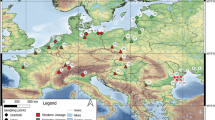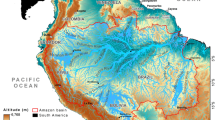Abstract
In metapopulations, the maintenance of local populations can depend on source–sink dynamics, where populations with positive growth rate seed populations with negative growth rate. The pattern and probability of successful dispersal among habitats can therefore be crucial in determining whether local populations will become rare or increase in abundance. We present here data on the dispersal strategy and population dynamics of three marine amphipods living in pen shells (Atrina rigida) in the Gulf of Mexico. The three amphipod species in this study disperse at different life stages. Neomegamphopus hiatus and Melita nitida disperse as adults, while Bemlos unicornis disperses as juveniles. The two species that disperse as adults have the highest initial population sizes when a new shell becomes available, likely caused by the arriving females releasing their brood into these recently occupied shells. This dispersal pattern results in initially higher population growth, but fewer occupied shells, as noted by their clumped distribution. In contrast, the species that disperses as juveniles accumulates more slowly and more evenly across habitats, eventually dominating the other two in terms of numerical abundance. The metapopulation dynamics of the three species seems to be highly dependent on the life history stage involved in dispersal.



Similar content being viewed by others
References
Amarasekare P (2004) The role of density-dependent dispersal in source-sink dynamics. J Theor Biol 226:159–168
Amarasekare P, Hoopes MF, Mouquet N, Holyoak M (2004) Mechanisms of coexistence in competitive metacommunities. Am Nat 164:310–326
Borowsky B (1983) Behaviors associated with tube-sharing in Microdeutopus Gryllotalpa (Costa) (Crustacea: Amphipoda). J Exp Mar Biol Ecol 68:39–51
Borowsky B (1990) Patterns of reproduction of some amphipod crustaceans and insights into the nature of their stimuli. In: Bauer RT, Martin JW (eds) Crustacean sexual biology. Columbia University Press, New York
Bousfield EL (1973) Shallow-water Gammaridean Amphipoda of New England. Cornell University Press, Ithaca
Caffey HM (1985) Spatial and temporal variation in settlement and recruitment of intertidal barnacles. Ecol Monogr 55:313–332
Edwards TD, Cowell BC (1992) Population dynamics and secondary production of Hyalella azteca (Amphipoda) in Typha stands of a subtropical Florida lake. J North Am Benthol Soc 11:69–79
Gerrodette T (1981) Dispersal of the solitary coral Balanophylla elegans by demersal planular larvae. Ecology 62:611–619
Gilg MR, Hilbish TJ (2003) Patterns of larval dispersal and their effect on the maintenance of a blue mussel hybrid zone in southwestern England. Evolution 57:1061–1077
Gosselin LA, Chia FS (1995) Distribution and dispersal of early juvenile snails: Effectiveness of intertidal microhabitats as refuges and food sources. Mar Ecol Prog Ser 128:213–223
Grosberg RK (1991) Sperm-mediated gene flow and the genetic-structure of a population of the colonial ascidian Botryllus schlosseri. Evolution 45:130–142
Gundersen G, Johannesen E, Andreassen HP, Ims RA (2001) Source-sink dynamics: how sinks affect demography of sources. Ecol Lett 4:14–21
Highsmith RC (1982) Reproduction by fragmentation in corals. Mar Ecol Prog Ser 7:207–226
Holt RD (1993) Ecology at the mesoscale: the influence of regional processes on local communities. In: Ricklefs RE, Schluter D (eds) Species diversity in ecological communities. Chicago University Press, Chicago, pp 77–88
Junkins R, Kelaher B, Levinton J (2006) Contributions of adult oligochaete emigration and immigration in a dynamic soft-sediment community. J Exp Mar Biol Ecol 330:208–220
Krebs CJ (1999) Ecological methodology, 2nd edn. Addison-Welsey Educational Publ, Menlo Park
Kuhlmann ML (1996) Indirect effects among species in a Northern Gulf of Mexico seagrass community. PhD thesis, Florida State University, Tallahassee
Leibold MA, Holyoak M, Mouquet N, Amarasekare P, Chase JM, Hoopes MF, Holt RD, Shurin JB, Law R, Tilman D, Loreau M, Gonzalezet A (2004) The metacommunity concept: a framework for multi-scale community ecology. Ecol Lett 7:601–613
Loreau M, Mouquet N (1999) Immigration and the maintenance of local species diversity. Am Nat 154:427–440
Martel A, Chia FS (1991) Drifting and dispersal of small bivalves and gastropods with direct development. J Exp Mar Biol Ecol 150:131–147
Mouquet N, Loreau M (2003) Community patterns in source-sink metacommunities. Am Nat 162:544–557
Munguia P (2004) Successional patterns on pen shell communities at local and regional scales. J Anim Ecol 73:64–74
Munguia P (2007) Spatial structure of communities on dead pen shells (Atrina rigida) in sea grass beds. Mar Biol (in press)
Olivier F, Vallet C, Dauvin JC, Retiere C (1996) Drifting in post-larvae and juveniles in an Abra alba (Wood) community of the eastern part of the Bay of Seine (English Channel). J Exp Mar Biol Ecol 199:89–109
Olson RR (1985) The consequences of short-distance larval dispersal in a sessile marine invertebrate. Ecology 66:30–39
Palmer MA, Allan JD, Butman CA (1996) Dispersal as a regional process affecting the local dynamics of marine and stream benthic invertebrates. Trends Ecol Evol 11:322–326
Pulliam HR (1988) Sources, sinks, and population regulation. Am Nat 132:652–661
Scheltema RS (1986) On dispersal and planktonic larvae of benthic invertebrates – an eclectic overview and summary of problems. Bull Mar Sci 39:290–322
Sotka EE, Wares JP, Barth JA, Grosberg RK, Palumbi SR (2004) Strong genetic clines and geographical variation in gene flow in the rocky intertidal barnacle Balanus glandula. Mol Ecol 13:21443–22156
Swearer SE, Caselle JE, Lea DW, Warner R (1999) Larval retention and recruitment in an island population of a coral-reef fish. Nature 402:799–802
Thomas JD (1993) Identification manual for the marine Amphipoda: (Gammaridea) I. Common coral reef and rocky bottom amphipods of South Florida, vol 83. Bureau of Laboratories, Department of Environmental Protection, Talahassee, pp 81–101
Todd CD, Lambert WJ, Thorpe JP (1998) The genetic structure of intertidal populations of two species of nudibranch molluscs with planktotrophic and pelagic lecithotrophic larval stages: are pelagic larvae “for” dispersal? J Exp Mar Biol Ecol 228:1–28
Zar JH (1999) Biostatistical analysis, 4th edn. Prentice-Hall, Upper Saddle River
Acknowledgments
We would like to thank D. Ferrell, N. Fogarty, K. Lotterhos, T. Miller, and C. terHorst for comments on earlier versions of the manuscript. Many thanks to B. Ehrmann, A. Schweikart, C. Scott, C. Stokes, and E. Yambaski for field assistance. This research was partially supported by a Gramlin Award, Florida State University. The experiments in this study comply with the current laws of the United States.
Author information
Authors and Affiliations
Corresponding author
Additional information
Communicated by Craig Osenberg.
Electronic supplementary material
Below is the link to the electronic supplementary material.
Rights and permissions
About this article
Cite this article
Munguia, P., Mackie, C. & Levitan, D.R. The influence of stage-dependent dispersal on the population dynamics of three amphipod species. Oecologia 153, 533–541 (2007). https://doi.org/10.1007/s00442-007-0762-7
Received:
Accepted:
Published:
Issue Date:
DOI: https://doi.org/10.1007/s00442-007-0762-7




